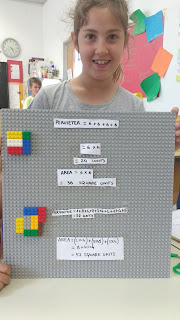Students of class 5, working in small groups, have drawn and built with the use of Legos some basic shapes, as squares and rectangles, and then they have begun to combine these basic shapes together to create more complex figures.
They have started measuring the perimeter. They have isolated before the perimeter drawing the
outline of the shapes on the paper and then they have counted the units around
the space of the Lego polygons built. They have also multiplied the units of
one side by 4 to calculate the perimeter of lego squares and the units of the 2
different sides by 2 to find the perimeter in the rectangles.
The students have constructed different shapes within a given outline
using Legos to understand that a closed figure or a space covers area and they
can find it using the square units.
Student have measured the area of the Lego shapes built in different
ways: counting the circles on top of the lego blocks, adding up all the square
units within the space of the Lego shapes, multiplying the lenght by the width of
the outlines. To measure the complex Lego shapes pupils have broken the figure
up into smaller other shapes (squares and rectangles) and they have calculate
the total area adding up the single areas. They were able to write multiplication
sentences about the measurements found.
In this activity students could better visualize the sense of
perimeter and area, share the different strategies used, reinforcing perimeter
and area skills.
They have also practised perimeter and area, having a lot of fun, in
the Area Dice Game taken from http://reliefteachingideas.com/area-dice-game/
.

































